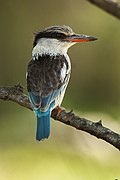Superregnum: Eukaryota
Cladus: Unikonta
Cladus: Opisthokonta
Cladus: Holozoa
Regnum: Animalia
Subregnum: Eumetazoa
Cladus: Bilateria
Cladus: Nephrozoa
Superphylum: Deuterostomia
Phylum: Chordata
Subphylum: Vertebrata
Infraphylum: Gnathostomata
Megaclassis: Osteichthyes
Cladus: Sarcopterygii
Cladus: Rhipidistia
Cladus: Tetrapodomorpha
Cladus: Eotetrapodiformes
Cladus: Elpistostegalia
Superclassis: Tetrapoda
Cladus: Reptiliomorpha
Cladus: Amniota
Classis: Reptilia
Cladus: Eureptilia
Cladus: Romeriida
Subclassis: Diapsida
Cladus: Sauria
Infraclassis: Archosauromorpha
Cladus: Crurotarsi
Divisio: Archosauria
Cladus: Avemetatarsalia
Cladus: Ornithodira
Subtaxon: Dinosauromorpha
Cladus: Dinosauriformes
Cladus: Dracohors
Cladus: Dinosauria
Cladus: Saurischia
Cladus: Eusaurischia
Subordo: Theropoda
Cladus: Neotheropoda
Cladus: Averostra
Cladus: Tetanurae
Cladus: Avetheropoda
Cladus: Coelurosauria
Cladus: Tyrannoraptora
Cladus: Maniraptoromorpha
Cladus: Maniraptoriformes
Cladus: Maniraptora
Cladus: Pennaraptora
Cladus: Paraves
Cladus: Eumaniraptora
Cladus: Avialae
Infraclassis: Aves
Cladus: Avebrevicauda
Cladus: Pygostylia
Cladus: Ornithothoraces
Cladus: Ornithuromorpha
Cladus: Carinatae
Parvclassis: Neornithes
Cohors: Neognathae
Cladus: Neoaves
Ordo: Coraciiformes
Familia: Alcedinidae
Subfamilia: Halcyoninae
Genus: Halcyon
Species: H. albiventris – H. badia – H. chelicuti – H. coromanda – H. cyanoventris – H. leucocephala – H. malimbica – H. pileata – H. senegalensis – H. senegaloides – H. smyrnensis
Name
Halcyon Swainson, 1821
Typus
Alcedo senegalensis Linnaeus, 1766 = Halcyon senegalensis
References
Zoological Illustrations 1 text, pl.27
Vernacular names
русский: Зимородки-альционы
中文: 翡翠属
Halcyon (/ˈhælsiən/) is a genus of the tree kingfishers, near passerine birds in the subfamily Halcyoninae.
Taxonomy
The genus Halcyon was introduced by the English naturalist and artist William John Swainson in 1821. He named the type species as the woodland kingfisher (Halcyon senegalensis).[2]
"Halcyon" is a name for a bird in Greek legend generally associated with the kingfisher. There was an ancient belief that the bird nested on the sea, which it calmed in order to lay its eggs on a floating nest. Two weeks of calm weather were therefore expected around the winter solstice. This myth leads to the use of halcyon as a term for peace or calmness.[3]
The genus contains 12 species:[4]
| Image | Scientific name | Common Name | Distribution |
|---|---|---|---|
 |
Halcyon coromanda | Ruddy kingfisher | east and southeast Asia. |
 |
Halcyon smyrnensis | White-breasted kingfisher | from the Sinai east through the Indian subcontinent to China and Taiwan. |
 |
Halcyon gularis | Brown-breasted kingfisher | the Philippines |
 |
Halcyon cyanoventris | Javan kingfisher | Java and Bali |
 |
Halcyon badia | Chocolate-backed kingfisher | western Sub-Saharan Africa. |
 |
Halcyon pileata | Black-capped kingfisher | India east to China, Korea and Southeast Asia |
 |
Halcyon leucocephala | Grey-headed kingfisher | Cape Verde Islands off the north-west coast of Africa to Mauritania, Senegal and Gambia, east to Ethiopia, Somalia and southern Arabia and south to South Africa. |
 |
Halcyon albiventris | Brown-hooded kingfisher | Sub-Saharan Africa |
 |
Halcyon chelicuti | Striped kingfisher | Sub-Saharan Africa |
 |
Halcyon malimbica | Blue-breasted kingfisher | Equatorial Africa |
 |
Halcyon senegalensis | Woodland kingfisher | Africa south of the Sahara. |
 |
Halcyon senegaloides | Mangrove kingfisher | Somalia, south through Kenya, Tanzania and Mozambique, to South Africa |
However, other sources, including Fry & Fry, lump the genera Pelargopsis, Syma and Todirhamphus into Halcyon to make a much larger grouping.
Geographic distribution
The genus Halcyon in the current sense consists mainly of species resident in sub-Saharan Africa, with a couple of representatives in southern Asia, one of which, the white-throated kingfisher, occasionally reaches Europe. White-throated and ruddy kingfishers are at least partially migratory.
Habitat
Halcyon kingfishers are mostly large birds with heavy bills. They occur in a variety of habitats, with woodland of various types the preferred environment for most. They are “sit and wait” predators of small ground animals including large insects, rodents, snakes, and frogs, but some will also take fish.
References
"Alcedinidae". aviansystematics.org. The Trust for Avian Systematics. Retrieved 2023-07-25.
Swainson, William John (1821). Zoological illustrations. Vol. 1. London: Baldwin, Cradock, and Joy; and W. Wood. Plate 27 text.
"Halcyon days". The Phrase finder. Retrieved 2008-01-11.
Gill, Frank; Donsker, David, eds. (2017). "Rollers, ground rollers & kingfishers". World Bird List Version 7.2. International Ornithologists' Union. Retrieved 17 May 2017.
Sources
Fry, K & Fry, H.C. (2000): Kingfishers, Bee-eaters and Rollers. ISBN 0-691-08780-6.
Retrieved from "http://en.wikipedia.org/"
All text is available under the terms of the GNU Free Documentation License

